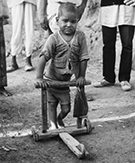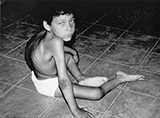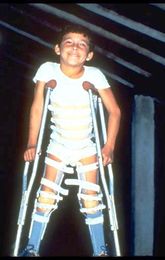Hesperian Health Guides
Rehabilitation of Children with Paralysis
HealthWiki > Disabled Village Children > Chapter 7: Paralysis > Rehabilitation of the Child with Paralysis
 |
| For this child, walking provides exercise that stretches his legs and feet, and prevents contractures. (Tilonia, India) |
All children with paralysis can be helped by certain basic rehabilitation measures, such as exercise to keep a full range of motion in their affected limbs.
However, each child will have a different combination and severity of paralyzed muscles, and therefore will also have his own specific needs.
For some children, normal exercise and play may be all that are needed. Others may require specific exercises and playthings. Still others may need braces or other aids to help them move about better, do things more easily, or keep their bodies in healthier, more useful positions. Those with the most severe paralysis may be helped most by a wheelboard (trolley) or wheelchair.
Every child needs to be carefully examined and evaluated in order to best meet their particular needs. The earlier you evaluate a child’s needs, and take steps to meet them, the better.
 |
 |
| This child, who had polio as a baby, already had several contractures in his hips, knees, and feet. (PROJIMO) | It took several months of exercises at home and then a series of plaster casts in the village rehabilitation center to straighten the contractures so he could walk without braces. |
Unfortunately, in many areas, village rehabilitation programs do not exist or are just beginning. Many children (and adults) with paralysis already have severe deformities or joint contractures. Often these must be corrected before a child can use braces or begin to walk.
Because contractures are such a common problem, we discuss them separately in the next chapter. Before evaluating a child with polio, we strongly suggest you read Chapter 8 on contractures.
WARNING! Before deciding on any aid or procedure, carefully consider its advantages and disadvantages. For example, some deformities may be best left uncorrected because they actually help a child with paralysis stand straighter or walk better. And some aids or braces may prevent a child from developing strength to walk without aids. Before deciding what aid or procedure to use, we suggest you read Chapter 56, “Making Sure Aids and Procedures Do More Good Than Harm.”
PROGRESS OF A CHILD WITH PARALYSIS
THE CHANGING NEEDS FOR AIDS AND ASSISTANCE
| 1. exercises to keep full range of motion, starting within days after paralysis appears and continuing throughout rehabilitation | 2. supported sitting in positions that help prevent contractures | 3. active exercises with limbs supported, to gain strength and maintain full motion | |||
 |
 |
 | |||
| 4. exercise in water— walking, floating, and swimming, with the weight of the limbs supported by the water |  | ||||
| 5. wheelboard or wheelchair with supports to prevent or correct early contractures | |||||
 |
 |
 | |||
Note: These also provide good arm exercise in preparation for walking with crutches. | |||||
| 6. braces to prevent contractures and prepare for walking | 7. parallel bars for beginning to balance and walk | ||||
 |
 |
||||
| 8. walking machine or “walker” | 9. crutches modified as walker for balance and extra support | ||||
 |
 | ||||
| 10. under arm crutches | 11. forearm crutches and perhaps in time . . . | 12. a cane or no arm supports at all | |||
 |
 |
 | |||
Note: These pictures are only an example — but most of the steps are necessary for many children. Children who begin rehabilitation late may also have contractures or deformities requiring corrective steps not shown here.


